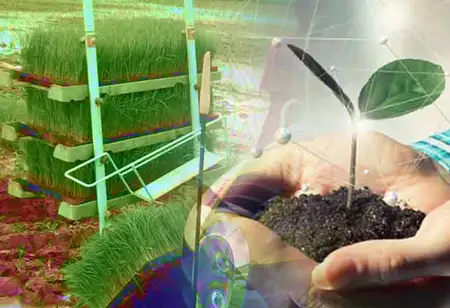Thank you for Subscribing to Agri Business Review Weekly Brief
Factors Influencing Seed Germination in Plants
Seed germination, a pivotal process in the life cycle of plants, is influenced by numerous factors, both abiotic and biotic.

By
Agri Business Review | Monday, September 11, 2023
Stay ahead of the industry with exclusive feature stories on the top companies, expert insights and the latest news delivered straight to your inbox. Subscribe today.
Seed germination success relies on factors like water, temperature, soil, light, and more. Managing these variables enhances crop cultivation and sustainable agriculture.
FREMONT, CA: Seed germination, a pivotal process in the life cycle of plants, is influenced by numerous factors, both abiotic and biotic. Among these, environmental factors play a crucial role in determining the success of this critical stage. Factors such as rainfall patterns, seasonal temperature fluctuations, and prevailing climate conditions exert significant control over when and how seeds sprout and develop into seedlings.
For instance, rainfall patterns dictate the availability of moisture necessary to initiate germination. Seeds often remain dormant until sufficient moisture is present in the soil, indicating the right conditions for growth. Similarly, seasonal temperature fluctuations act as cues for certain plant species, with many requiring specific temperature ranges to break dormancy and initiate germination.
Understanding these environmental factors is vital for conservation efforts, agriculture, and ecological restoration, as it enables the manipulation of conditions to optimise germination and promote plant propagation in diverse ecosystems. Ultimately, the intricate interplay of these factors shapes the germination strategies of various plant species, ensuring their survival and adaptation in their respective habitats.
Water
Water is a critical factor in seed germination. Seeds require moisture to rehydrate and activate enzymes responsible for breaking down stored nutrients and initiating growth. Adequate soil moisture is essential for the germination process. Insufficient water leads to poor germination rates or seed dormancy. Conversely, excessive moisture can lead to seed rot or fungal infections, compromising germination success.
Temperature
Temperature plays a pivotal role in seed germination. Different plant species have specific temperature requirements for optimal germination. Some seeds germinate better at cooler temperatures, while others thrive in warmer conditions. Temperature influences the rate of biochemical reactions within the seed, affecting the speed and uniformity of germination. Understanding the temperature preferences of specific seeds is crucial for successful germination.
Oxygen
Oxygen is essential for cellular respiration during germination, facilitating the conversion of stored energy reserves into usable forms for the growing seedling. Adequate soil aeration is necessary to ensure oxygen availability to the developing embryo. Compacted or waterlogged soils restrict oxygen diffusion, leading to poor germination and seedling mortality.
Light
The light requirement for germination varies among plant species. Some seeds require exposure to light to initiate germination, while others germinate best in darkness. This phenomenon, known as photoplasm, is essential for the adaptation and survival of various plant species in their respective habitats. Understanding the light requirements of seeds is essential for providing the optimal conditions for germination.
Seed Quality
Seed quality is a critical factor in germination success. High-quality seeds possess good viability, germination potential, and genetic purity. Poor-quality seeds may be damaged, diseased, or have low vigour, resulting in low germination rates and weak seedlings. Seed quality is influenced by factors such as seed storage conditions, genetics, and seed treatment practices.
Soil Type and Composition
Soil type and composition significantly impact seed germination. Seeds require a suitable substrate with the right texture, nutrient content, and pH levels. For example, sandy soils drain quickly and necessitate more frequent watering, while clayey soils retain moisture. Testing and amending soil as necessary are crucial for creating an ideal environment for germination.
Nutrients and Fertilisation
Adequate nutrient availability is essential for seed germination and early seedling growth. Seeds contain stored nutrients that sustain the emerging seedling until it can establish roots and access external nutrient sources. Adding fertilizers or organic matter to the soil provides the necessary nutrients for germinating seeds.
Seed Scarification
Some seeds have hard seed coats that inhibit water absorption and germination. Scarification is a process involving mechanical or chemical methods to break or soften the seed coat, facilitating germination. This technique is especially useful for species with seeds that have evolved to withstand harsh environmental conditions.
Seed Dormancy
Seed dormancy is a natural mechanism that prevents germination under unfavourable conditions, ensuring that seeds germinate when environmental conditions are suitable for seedling survival. Various types of seed dormancy exist, including physical, physiological, and morphological dormancy. Understanding and breaking seed dormancy through appropriate treatments can improve germination rates.
Microorganisms and Pathogens
Microorganisms in the soil impact seed germination either positively or negatively. Beneficial microbes enhance nutrient availability and protect seeds from pathogens. However, harmful pathogens, such as fungi and bacteria, can cause seed rot and reduce germination rates. Seed treatment with fungicides or biocontrol agents can mitigate the negative effects of pathogens.
Seed Age
Seed age affects germination rates. Generally, fresher seeds tend to have higher germination potential than older seeds. However, some species may benefit from a period of after-ripening or stratification to break dormancy and improve germination.
Environmental Factors
In natural settings, seed germination is profoundly influenced by environmental elements, including precipitation patterns, seasonal temperature variations, and overall climatic conditions. Numerous plant species have evolved specialised germination tactics finely attuned to distinct environmental signals. This adaptation guarantees that seedlings emerge precisely when circumstances are most favourable for their subsequent development and growth.
Successful seed germination is influenced by a complex interplay of factors, including water, temperature, oxygen, light, seed quality, soil type, nutrients, scarification, dormancy, microorganisms, seed age, and environmental conditions. Farmers, gardeners, and horticulturists consider these factors when planning for crop cultivation or plant propagation. By understanding and managing these variables, they can optimise germination rates, promote healthy seedlings, and ultimately contribute to more successful and sustainable agricultural and horticultural practices.





